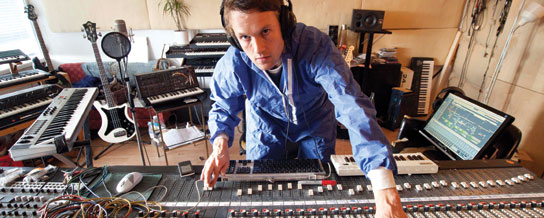In the Studio: Medasyn
Lady Sovereign’s producer takes grime out of the PlayStation and into the mixing desk. As […]

In the Studio: Medasyn
Lady Sovereign’s producer takes grime out of the PlayStation and into the mixing desk. As […]

Lady Sovereign’s producer takes grime out of the PlayStation and into the mixing desk.
As Lady Sovereign’s right-hand man, Hackney-based Gabriel Olegavich (a.k.a. Medasyn) has the difficult task of creating polished genres on the fly. Wedged somewhere between grime, hip-hop, electro, and straight-up pop, the beats he and Sovereign come up with are often inspired by gritty underground styles, but they still require well-honed pop instincts and methods. As such, there isn’t much room for shoddy PlayStation beats or murky mixes—the tracks on Sov’s new album, Jigsaw, are about as radio-friendly as it gets. Olegavich filled us in on how he builds that polish without losing the natural feel.
XLR8R: Can you describe your current signal path for vocals?
Medasyn: I’ve been building the studio up for a long time now, but maybe six or seven years ago I got a Soundtracs [Inline 36] analog mixing desk. That’s a big part of the sound, since everything runs through it. On the front-end, I use a Neumann M 147 tube [microphone], which is really nice—I think it has a bit more body than the U87. That goes into a Chandler Germanium pre-amp that I got in New York about a year ago. Prior to that, I was using the pre-amps on the mixing desk. Now, pretty much all the vocals for Jigsaw were recorded through the Chandler.
How much of a difference did recording through a nicer pre-amp make?
It’s amazing; I should have gotten it years ago. It just adds something to the signal—this sort of smoothness. Some of the frequencies just feel better. And after working with a few female MCs besides Sovereign, I’ve found you have to be really careful with some of the mid-range, especially around 2k. It can get quite pokey and in-your-face. But with a nice pre-amp, there’s a lot less frequency you have to tame—it gives a much better signal to start with. Are your beats done in hardware as well? Actually, I use Logic. The ESX sampler gets quite a bit of use as I’ve built up a pretty huge collection of drum sounds for it. In the past, I used Akai samplers, and I’ve got an MPC, too, but in the U.K., there’s definitely more of a Logic culture than, say, an MPC culture. But I still play beats off a keyboard, and try to quantize them as little as possible—just enough to add a little bit of rigidity so it’ll still fit with other pieces, like guitar.Speaking of guitar, there’s a lot of traditional “acoustic” instrumentation on Jigsaw. Did you layer in those parts as you went, or was it a more pieced-together loop approach? Almost everything on the new album was done as we went. With the exception of the underlying beat for “Jigsaw,” which I had originally done with another project in mind, the beats largely came together with Sovereign and I in the studio together. I’d be programming drums, for example, and she’d vibe off it. It was an exchange, like, “This part sounds good,” or “Let’s try guitar here.” And I think that’s the best way to work—it feels more “right” when there’s that exchange. Even if I added some synth lines in after she’d gone home or whatever, having the root of the song be collaborative was important.There’s a lot of interplay between your basslines and the kick drums on the album. Is it ever tough to get those elements mixed together properly? When we first set up my studio, we put this bass trap in the ceiling, and sometimes I still get really paranoid about it. Am I hearing all the bass, and that sort of thing. But yeah, that can be a funny one. There is, of course, the safe way of doing it, which is using sidechain compression with the kick and bassline—that way the sounds won’t really clash because you can make one get ducked by the other. That was used to a ridiculous extreme on “I Got You Dancing.”Did you lean towards any specific gear for creating bass sounds? I find the Korg MS-10 is really good for when I want to make some kind of crazy pitch-bend bass noises or filter sweeps. It’s got a very tough sound to it, too—it doesn’t have that same older, warmer sound like, say, a [Roland] Jupiter 4. It can also be a lot quicker than some of the plug-ins because you’ve got all the knobs in front of you—you just fiddle around with it, and boom, you’ve got the sound you need. For those certain things, plug-ins can actually be more complicated.

